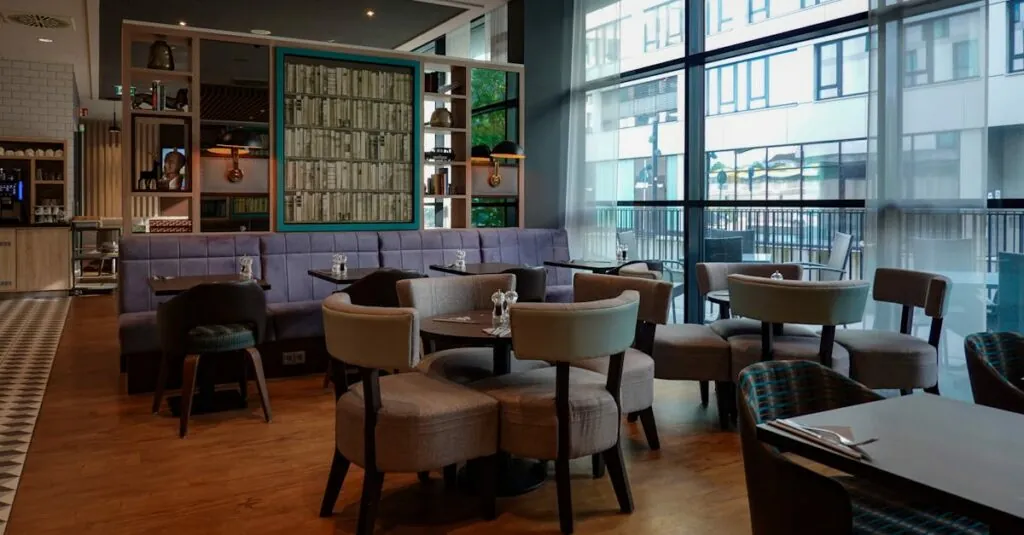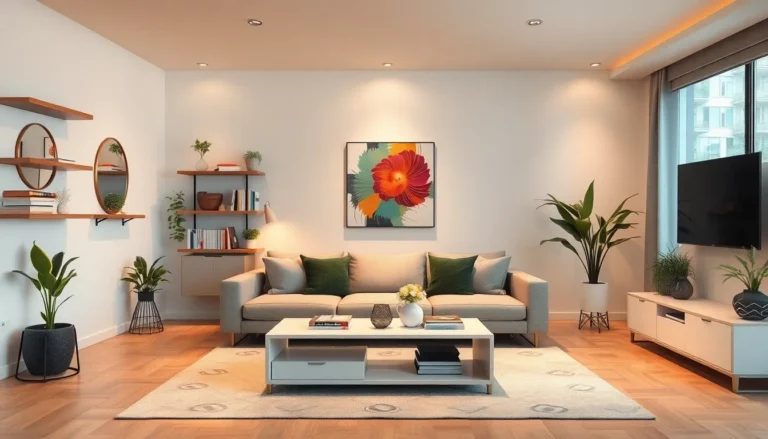In a world where first impressions count, the interior of a commercial space can make or break a business. Imagine walking into an office that feels like a cozy coffee shop, or a retail store that’s practically begging you to browse. That’s the magic of interior commercial design—it’s not just about aesthetics; it’s about creating an experience that keeps customers coming back for more.
Table of Contents
ToggleOverview of Interior Commercial Design
Interior commercial design significantly influences the functionality and aesthetics of business spaces. It involves designing environments that enhance customer experience while meeting operational needs.
Definition and Scope
Interior commercial design encompasses the planning and execution of spaces meant for public use, such as offices, retail stores, and restaurants. It integrates architectural elements, furniture selection, color schemes, and lighting choices to create cohesive environments. Professionals in this field consider both form and function, ensuring that spaces are not only visually appealing but also supportive of the business’s goals. Effective designs facilitate workflow, enhance brand identity, and accommodate user needs, thus ensuring successful interactions.
Importance in Business Environments
Design impacts first impressions in commercial settings, making well-designed spaces essential for attracting customers. Effective interior design promotes comfort and efficiency, contributing to employee satisfaction and productivity. For instance, thoughtful layouts in offices can encourage collaboration, while inviting retail spaces can boost sales. An appealing environment fosters a positive brand image, which aids in customer retention. Statistics reveal that nearly 75% of consumers judge a business based on its interior aesthetics, highlighting the pivotal role of design in guiding consumer behavior.
Key Elements of Interior Commercial Design
Key elements play a vital role in creating effective interior commercial designs. Factors like space planning and color schemes directly impact customer experience and business functionality.
Space Planning
Space planning involves organizing furniture and fixtures for optimal functionality. Effective layouts ensure smooth customer flow and enhance usability. Designers prioritize creating distinct zones that encourage interaction while maintaining privacy. Flexibility in design caters to various business needs, whether it’s hosting events or daily operations. Utilizing technology tools helps visualize space before implementation. Measurements and accessibility standards are crucial in meeting the needs of all users. Proper space planning enhances overall efficiency, fostering a welcoming atmosphere that drives customer engagement.
Color Schemes and Materials
Color schemes and materials significantly influence the ambiance of commercial spaces. Choosing the right colors sets the tone and evokes specific emotions. Neutral palettes often promote calmness, while vibrant colors inspire energy and creativity. Material selection contributes to durability and maintenance, with options ranging from natural woods to modern metals. Sustainability plays a key role in material choices, as eco-friendly options gain popularity among consumers. Designers enhance brand identity by aligning color schemes with business values. Ultimately, thoughtful combinations of colors and materials create cohesive environments that resonate with clients and promote lasting impressions.
Trends in Interior Commercial Design
Interior commercial design is evolving, with trends shaping how businesses create inviting, functional spaces. These trends reflect changing consumer preferences and technological advancements.
Sustainable Design Practices
Sustainable design practices are gaining traction in commercial spaces. Many businesses prioritize eco-friendly materials, which reduce environmental impact and resonate with eco-conscious consumers. Reclaimed wood, recycled metals, and energy-efficient fixtures enhance space aesthetics while promoting sustainability. Green certifications increasingly attract clients, boosting a brand’s appeal. Incorporating natural elements such as indoor plants improves air quality, contributing to a healthier environment. Color choices are also shifting towards earthy tones, which create warm, inviting atmospheres.
Technology Integration
Technology integration in interior commercial design enhances user experience. Smart building systems streamline operations, enabling businesses to control lighting, temperature, and security through mobile applications. Virtual reality tools assist designers and clients in visualizing concepts, making decision-making more efficient. Interactive displays and digital signage engage customers, providing instant information about products and services. Moreover, augmented reality offers innovative ways to showcase designs and assist in space planning. Integrating these technologies transforms commercial spaces into dynamic environments that adapt to both business needs and consumer expectations.
Challenges in Interior Commercial Design
Interior commercial design faces several challenges that impact project outcomes. Addressing these concerns ensures effective and functional environments.
Budget Constraints
Budget constraints often limit design options. Designers frequently navigate tight financial parameters, leading to compromises in materials and finishes. Balancing quality and affordability proves crucial in delivering a successful project. When nearly 75% of consumers evaluate a business based on aesthetics, staying within budget without sacrificing design integrity becomes essential. Allocating resources efficiently can maximize both functionality and appearance. Effective planning and prioritization of expenditures allow designers to focus on the most impactful elements, like lighting and layout.
Client Expectations
Client expectations can create significant pressure on design outcomes. Clear communication about capabilities often helps align visions. Understanding what clients prioritize enables designers to tailor solutions that meet specific needs. Many clients expect innovative designs that stand out and attract customers. Designers must manage these expectations while adhering to practical limitations. Meeting both creative aspirations and operational requirements is crucial for success. Regular updates and feedback loops keep clients informed and engaged throughout the process, fostering collaboration and satisfaction.
Interior commercial design is a vital component of a business’s success. It shapes the customer experience and influences brand perception while enhancing functionality and employee satisfaction. By prioritizing thoughtful design elements like space planning and sustainable materials, businesses can create environments that resonate with their target audience.
As trends evolve and technology advances, the importance of adapting to these changes becomes clear. Embracing innovative solutions not only attracts customers but also fosters loyalty and repeat visits. Ultimately, investing in quality interior design is an investment in the future of any commercial enterprise.








